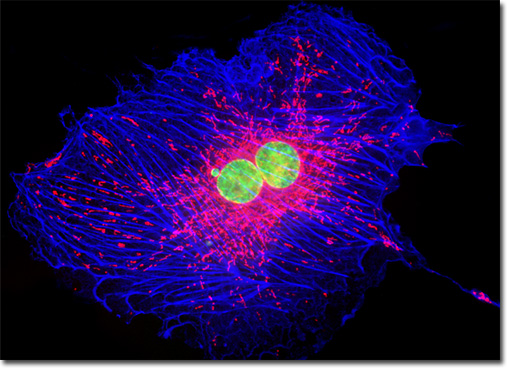Fluorescence Digital Image Gallery
Normal Rat Kidney Epithelial Cells (NRK)
|
A kidney, like the one that served as a source for the NRK cell line, is a major vertebrate excretory organ. The basic filtering unit of the kidney is the nephron, which consists of a renal corpuscle and a renal tubule. A normal adult human kidney may contain more than a million nephrons. Through the use of countercurrent exchange mechanisms, nephrons filter all of the water and soluble materials that pass through them. The units then reabsorb the substances that are needed and excrete the remainder. This function is extremely important to the body, which can suffer greatly if toxic substances are allowed to build-up. Humans can often lead a normal life if only one kidney is in good health, but if both of the organs are damaged, dialysis becomes necessary on a regular basis in order to filter the blood mechanically. The F-actin present in the culture of NRK epithelial cells presented in the digital image above was targeted with Alexa Fluor 350 conjugated to phalloidin, a bicyclic peptide isolated from the death cap mushroom (Amanita phalloides). In addition, the culture was labeled for mitochondria with MitoTracker Red CMXRos, and for nuclei with SYTOX Green. Images were recorded in grayscale with a QImaging Retiga Fast-EXi camera system coupled to an Olympus BX-51 microscope equipped with bandpass emission fluorescence filter optical blocks provided by Omega Optical. During the processing stage, individual image channels were pseudocolored with RGB values corresponding to each of the fluorophore emission spectral profiles. |
© 1995-2025 by Michael W. Davidson and The Florida State University. All Rights Reserved. No images, graphics, software, scripts, or applets may be reproduced or used in any manner without permission from the copyright holders. Use of this website means you agree to all of the Legal Terms and Conditions set forth by the owners.
This website is maintained by our
|
